I might be the odd one out, but I hate reading on screens. Whether it's an article, a long PDF, a journal article, a short news piece, or a full-length book--I just don't like taking in important information or even reading for leisure on a screen. I've tried reading on my phone, a tablet, a digital/e-reader, laptop, and large desktop monitor, and they all seem to fall short of paper-based reading. Not only do I like the feel of holding paper or a book as I read, I also sense that something different is happening in my brain. I tend to skim and miss information when I read from screens, and I can tell that my brain assigns greater value (mental energy, focus, etc.) to paper-based reading.
Because this is my own personal experience with screens and paper, I naturally assume that reading comprehension is greater with paper-based reading. This assumption feeds a growing concern I have for the steep increase in digital reading and learning that we have all experienced in the last few years.
With so many young students suddenly and unexpectedly moved into online learning in the last two years, the amount of screen time and reading from screens has risen beyond its already high levels. Many U.S. schools were already providing a school-issued device to each student, a trend known as one-to-one computing in the education world. And even more U.S. schools attempted to quickly pivot to one-to-one pivoting when learning was forced to go online in 2020. Textbook publishers are also digitizing so much of their content. Pearson announced in 2019 that is adopting a digital-first strategy, prioritizing the publication of digital textbooks.
These trends cause me to pause and consider what reading will look like for my own children and students as they continue through their formal education. If my child is using apps to practice reading skills, if my middle school students are completing all of their homework on Chromebooks, if high schoolers are using digital textbooks for each of their core classes, how will this impact their comprehension and overall learning experience? Is the reading that they do on screens as impactful--as meaningful--as what they can understand and absorb through paper books and paper-based reading.
I asked these questions and more to University of North Dakota Associate Professor of Education Dr. Virginia Clinton-Lisell. She has conducted extensive research and many meta-analyses on the topic of reading comprehension, specifically examining screen-based reading and paper-based reading. In hearing some of the findings of her work, I was surprised and relieved to hear a couple of key takeaways:
- Though paper-based reading does edge out screen-based reading when it comes to comprehension, the paper-based advantage is arguably small.
- The possible added features of e-texts can truly help students with their ability to comprehend.
- Paper is technology, too. In the same way that we teach children to read books (hold them, check for comprehension, use visual cues, etc.), we can teach children how to read and learn through screen-based media and it still be impactful.
Above all, Dr. Clinton-Lisell asserts, "Reading is reading. If your child is reading, that is a good thing. E-readers and digital texts provide expanded access to content that can benefit children." It's important to encourage our kids to read in anyway that they feel comfortable, paper or screen.
[To hear more from Dr. Clinton-Lisell's research, make sure to listen to "Screen-Based Reading versus Paper-Based Reading: What Does the Research Say?" an episode of the "Navigating Your Child's Education" podcast for parents.]
/Logos/Horizontal%20Academic%20Logo%20for%20Light%20Backgrounds.png)
/Logos/Horizontal%20Academic%20Logo%20for%20Dark%20Backgrounds.png)


.jpg)
